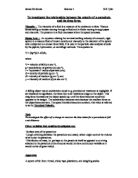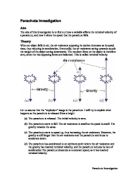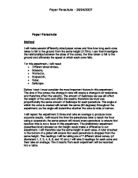James De Souza Science 1 B.E.Tyler
To investigate the relationship between the velocity of a parachute and the drag force.
Viscosity :- The viscosity of a fluid is a measure of its resistance to flow. Viscous forces acting on bodies moving through a fluid and in fluids moving through pipes and channels. The pressure in a fluid decreases where the speed increases.
Stokes Law :- An equation relating the terminal settling velocity of a smooth, rigid sphere in a viscous fluid of known density and viscosity to the diameter of the sphere when subjected to a known force field. It is used in the particle-size analysis of soils by the pipette, hydrometer, or centrifuge methods. The equation is:
V = (2gr²)(d1-d2)/9µ
where
V = velocity of fall (cm sec-¹),
g = acceleration of gravity (cm sec-²),
r = "equivalent" radius of particle (cm),
dl = density of particle (g cm -³),
d2 = density of medium (g cm-³), and
µ = viscosity of medium (dyne sec cm-²).
A falling object has an acceleration equal to g, provided air resistance is negligible. If air resistance is significant, the force due to air resistance drags on the object. This drag force increases as the object speeds up, until the force becomes equal and opposite to its weight. The acceleration becomes zero because the resultant force on the object becomes zero. The speed therefore becomes constant; this value is referred to as the Terminal Velocity.
Task
To investigate the effect of a change in mass on the time taken for a parachute to fall a set distance.
Other variables that could be investigated are:
· Surface area of the parachute
· Length of string (between the parachute and mass), which might control the volume of air under the parachute.
· Distribution of mass, i.e. perhaps on the parachute itself as opposed to on string attached to the parachute (this of course would not be a continuous variable so it would not be of great value).
Apparatus
A square of bin liner, thread, sticky tape, plasticene, and weighing scales.
Method
One parachute was assembled using a square of bin liner, thread and sticky tape. The thread was tied in such a way that plasticene masses could be attached. For each mass, the experiment was performed three times and after completion, the entire investigation was repeated. The actual experiments consisted of timing how long the parachute took to travel from the ceiling to the floor, a distance of 2.85 metres. The measurements were taken in grams and then converted into Newton’s for more accurate results.
In order to make this a fair test I am going to keep a number of things constant, e.g., the bin liner parachute, the length of the string, the distance for it to fall, the surface area of the parachute, and the distribution of mass.
Diagram
Predictions
· The larger the mass, the shorter the time because when the mass is larger the parachute accelerates to a higher speed due to the terminal velocity being higher.
Theory
Velocity = Distance
Time
Acceleration = Increase in Velocity
Time
Results
Experiment 1
Mass (N) Time 1 (s) Time 2 (s) Time 3 (s) Average Time (s) Average Velocity (m/s)* Average Acceleration (m/s2)…
0.02 3.35 3.29 3.31 3.32 0.86 0.26
0.04 2.17 2.35 2.18 2.23 1.28 0.57
0.06 1.72 1.88 1.64 1.75 1.63 0.93
0.08 1.58 1.65 1.62 1.62 1.76 1.09
0.10 1.46 1.41 1.23 1.37 2.08 1.52
0.12 1.26 1.29 1.31 1.29 2.21 1.71
0.14 1.11 1.27 1.08 1.15 2.48 2.16
0.16 1.15 1.13 1.04 1.11 2.57 2.32
0.18 1.04 1.18 1.05 1.09 2.61 2.39
0.20 1.03 0.97 1.10 1.04 2.74 2.63
Experiment 2
Mass (N) Time 1 (s) Time 2 (s) Time 3 (s) Average Time (s) Average Velocity (m/s)* Average Acceleration (m/s2)…
0.02 2.78 2.32 3.28 2.79 1.02 0.37
0.04 2.18 2.30 1.67 2.05 1.39 0.68
0.06 1.57 1.40 1.50 1.49 1.91 1.28
0.08 1.09 1.14 1.25 1.16 2.46 2.12
0.10 1.19 1.31 1.29 1.26 2.26 1.79
0.12 1.13 1.20 1.14 1.16 2.46 2.12
0.14 1.09 1.07 1.13 1.10 2.59 2.35
0.16 0.91 1.08 1.10 1.03 2.77 2.69
0.18 0.88 1.01 1.06 0.98 2.91 2.97
0.20 0.93 0.97 1.00 0.97 2.94 3.03








